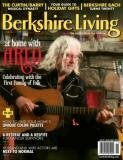THE BEAT GOES ON: House Music
Back in 1822, the immortal phrase, “Be it ever so humble, there’s no place like home” appeared in the song “Home! Sweet Home!” by John Howard Payne and Sir Henry Bishop. In the rock era, Crosby, Stills, Nash and Young made one’s home a metaphor for domestic bliss in the Graham  Nash-penned “Our House,” when they sang, “Our house is a very, very, very fine house, with two cats in the yard, life used to be so hard, now everything is easy ’cause of you.” (If you’re reading this before September 1, you can hear Crosby, Stills and Nash sing this song at Tanglewood that night.) And, around the same time that CSNY painted that scene of domestic bliss, Kenny Loggins and his duo-mate, Jim Messina, recorded “House at Pooh Corner,” which portrayed a storybook scene of childlike innocence surrounding a house.
Nash-penned “Our House,” when they sang, “Our house is a very, very, very fine house, with two cats in the yard, life used to be so hard, now everything is easy ’cause of you.” (If you’re reading this before September 1, you can hear Crosby, Stills and Nash sing this song at Tanglewood that night.) And, around the same time that CSNY painted that scene of domestic bliss, Kenny Loggins and his duo-mate, Jim Messina, recorded “House at Pooh Corner,” which portrayed a storybook scene of childlike innocence surrounding a house.
As reflected in these idylls, the concept of home typically conjures up images of warmth and security. But in 1964, Dionne Warwick sang, “A house is not a home,” in a song of that title by the great songwriting team of Burt Bacharach and Hal David. If popular song mirrors the sentiments of the prevailing culture, there is a lot more to the meaning of “house” and “home” than a place to hang one’s hat. Home, it turns out, can be a place of ambivalence, anxiety, or even heartbreak. It’s not for nothing, after all, that a child of divorce is said to come from a “broken home.”
Take David Byrne’s ambiguous thoughts about home as expressed in the Talking Heads song, “This Must Be the Place (Naive Melody)”:
Home is where I want to be
But I guess I’m already there
I come home, she lifted up her wings
Guess that this must be the place.
Here, the narrator longs to be home, but isn’t even sure if he’s “already there.” And it seems that the keeper of the nest—mother? wife?—might have left as soon as he returned. This is a long way from Graham Nash’s idealization of home as Eden.
As wonderful a place as home can be, the inability to be there prompts a type of longing that, linguistically at least, is on a par with illness—“homesickness.” In “Home Again,” Carole King captured those desperate feelings:
Sometimes I wonder if I’m ever gonna make it home again
It’s so far and out of sight ...
I won’t be happy till I see you alone again
Till I’m home again and feeling right.
King’s is a sentiment common to songwriters who tire of the touring life and yearn for the security of home, mirrored in the Simon and Garfunkel classic, “Homeward Bound,” which is tinged with a very Paul Simon-like acerbity:
Tonight I’ll sing my songs again,
I’ll play the game and pretend.
But all my words come back to me in shades of mediocrity
Like emptiness in harmony I need someone to comfort me.
Homeward bound,
I wish I was,
Homeward bound.
So much for his fans.
In the modern world, according to popular song, home is a point of departure, leaving those left behind saddened and grieving. Think of the Beatles and “She’s Leaving Home”:
She (we gave her most of our lives)
Is leaving (sacrificed most of our lives)
Home (we gave her everything money could buy)
She’s leaving home after living alone for
So many years (bye-bye).
At least the couple in “She’s Leaving Home,” bereft of their daughter, still have each other. For the narrator of Elvis Costello’s “This House Is Empty Now,” no such comfort remains:
This house is empty now
There’s nothing I can do to make you want to stay
So tell me how am I supposed to live without you.
Even the reassurance of home as a refuge is a double-edged sword in the hands of the mischievous songwriter Randy Newman, who loves nothing more than to create a scene of sweetness and then subvert it with terror. In “I’ll Be Home,” the narrator begins by reassuring his loved one:
I’ll be home
I’ll be home
When your nights are troubled
And you’re all alone
only to reveal in the next verse that the narrator himself is a sad sack who has been abandoned, left home alone:
I’ll be home
Wherever you may wander
And wherever you may roam
You come back
I’ll be waiting here for you
I’ll be home, I’ll be home, I’ll be home.
A home is also a place from which someone can be evicted or expelled. On her terrific Grammy Award-winning album, A Few Small Repairs, Shawn Colvin created an entire song cycle about unwanted comings and goings, expressed most directly in “Get Out of this House”:
Go jump in the lake, go ride up the hill
Get out of this house
It’s a house of your making, it’s a house of ill will
Get out of this house.
In “Disorder in the House,” Warren Zevon painted a nightmare familiar to many a homeowner beset by things falling apart:
Disorder in the house
The tub runneth over
Plaster’s falling down in pieces by the couch of pain ...
Disorder in the house
The doors are coming off the hinges
The earth will open and swallow up the real estate.
One certainly has the impression that Zevon is talking about more than merely a few small home repairs.
There are other kinds of houses, too, that, far from conjuring up domestic bliss, have the power to transform or terrify. A traditional folk song, “House of the Rising Sun,” immortalizes such a place:
There is a house in New Orleans
They call the Rising Sun
And it’s been the ruin of many a poor boy
And Lord I know I’m one.
And leave it to Bob Dylan to reverse the commonly held duality between “house” and “home” in his “Ballad of Frankie Lee and Judas Priest”:
“What kind of house is this,” he said
“Where I have come to roam?”
“It’s not a house,” said Judas Priest
“It’s not a house … it’s a home.”
That declaration leaves Priest’s interlocutor, Frankie Lee, trembling, foaming at the mouth, and, ultimately, to die. The moral, the narrator tells us, is “don’t go mistaking Paradise/ For that home across the road.”
And that’s as good advice as any. [SEPTEMBER 2010]
Seth Rogovoy is Berkshire Living’s award-winning editor-in-chief and cultural critic. He is the author of Bob Dylan: Prophet Mystic Poet.

 Delicious
Delicious Digg
Digg StumbleUpon
StumbleUpon Propeller
Propeller Reddit
Reddit Magnoliacom
Magnoliacom Newsvine
Newsvine Technorati
Technorati


